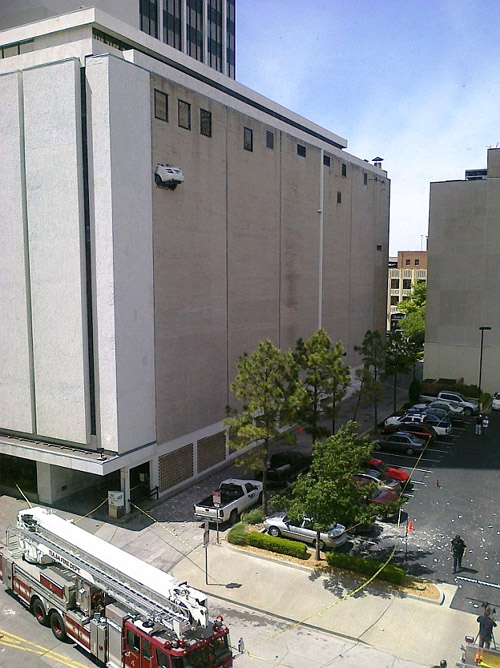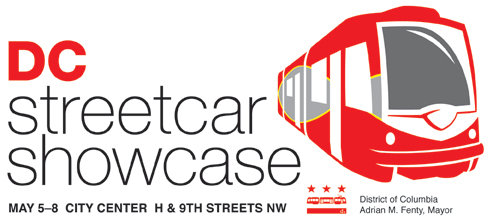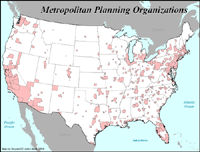|
Special Features





Image Libraries


|
|
Blog
Earlier this week the US Green Building Council officially launched LEED-ND, environmentally friendly standards for neighborhood development. I discuss the launch, and how it could revolutionize Smart Growth, on the Washington Post Local Blogging Network.
Average Rating: 4.4 out of 5 based on 207 user reviews.
April 30th, 2010 | Permalink
Tags: environment, urbandesign, washpostblog

Can you spot what’s wrong with this picture?

Why yes, that is a car crashed through the 7th floor of a parking garage.
This happened earlier this week in Tulsa, OK, when the driver’s foot got stuck on the accelerator while backing in to a parking space. Whoops.
From UK Daily Mail via Geekologie.
Average Rating: 4.6 out of 5 based on 227 user reviews.
April 29th, 2010 | Permalink
Tags: fun, roads/cars, transportation

Every so often the question of Washington’s height limit comes up. Someone suggests we raise it, and a debate ensues. I’m on record opposing raising the height limit in downtown Washington, but supporting much taller buildings in secondary nodes like Rosslyn.
I have opposed raising the limit downtown because:
- I don’t think concentrating any more office space downtown is necessarily in the region’s best interests. I’d rather we have a bunch of mixed-use neighborhoods than an office ghetto surrounded by bedroom communities.
- There’s so much available land near downtown in places like Southwest and NoMa that we have ample room to expand the central office district without needing to raise the height limit.
- I fear that eliminating the height limit downtown would result in a push to tear down and redevelop too many historic buildings that are culturally valuable.
However, there is one good reason why raising the height limit downtown could be beneficial: It could make downtown a better neighborhood.
Downtown Washington may be the most intensely built part of the region, but it is almost completely commercial. There are so few residential units that vast swaths of downtown are almost completely devoid of people outside the hours of 9-5. If I want Washington to be a city of mixed-use neighborhoods, then downtown is failing. Even the downtown BID thinks this is a problem.
Getting more residents downtown is hard, however. For one, the parts of downtown that are most in need of it are already built out with office buildings. For two, commercial square footage generally rents at a higher rate than residential square footage, so any developer that can build office is more likely to do so than residential. Even if we change the zoning to require new buildings be residential, developers won’t be likely to tear down older office buildings in order to replace them with lower-renting residential ones.
The only answer is probably to up the density for residential projects, but not commercial ones.
But by how much? We need there to be some redevelopment of existing buildings, just not too much.
We could simply allow residential skyscrapers at unlimited height, but that would defeat the aesthetic reasons for having any height limit at all, and it might lead to the sort of land rush from point number 3, above.
What about a smaller rise?
The height limit is currently defined as the width of the street plus 20 feet. It would be possible to rewrite the regulation to provide a height bonus in exchange for incorporating residential square footage, say 20 additional feet of height in exchange for three floors of residential.
For example, let’s say you own a piece of land on a 90 foot wide street. You would currently have the right to build a 110 foot tall building with 10 floors of office space. With my suggested bonus option, you’d instead have the right to build a 130 foot tall building with nine floors of office and three floors of residential.
That would be enough of a windfall for most developers of new buildings to take advantage, but it wouldn’t be so much that redeveloping existing buildlings would be worth the cost to do so, unless you were going to redevelop anyway. We wouldn’t see wholesale demolition of historic properties, but we would see a substantial residential component anywhere a new building went up for other reasons, which happens often enough (as the empty lot at the corner of K Street and Connecticut illustrates).
I still don’t think there is any reason to allow skyscrapers downtown, or to raise the limit for more offices, but a modest height bonus for residential development along these lines would add people to downtown’s streets without significantly altering the city’s midrise character. It would incrementally improve downtown as a neighborhood, while allowing it to retain its role as regional commercial center.
I think the idea is a winner.
 Cross-posted at Greater Greater Washington. Cross-posted at Greater Greater Washington.
Average Rating: 4.6 out of 5 based on 292 user reviews.
April 28th, 2010 | Permalink
Tags: proposal, urbandesign


The District Department of Transportation will be displaying one of its new streetcar vehicles on May 5-8 at 9th and H Streets, NW, in the parking lot where the old convention center was located. The streetcar will be open for the public to enter and walk around.
Admission is free. The schedule is as follows:
Wednesday, May 5, 11am – 7pm
Thursday, May 6, 11am – 7pm
Friday, May 7, 11am – 7pm
Saturday, May 8, 11am – 5pm
The streetcar is one of three DDOT purchased to run on the Anacostia route (where there is no prohibition against overhead wires) that arrived in December.
Average Rating: 4.5 out of 5 based on 198 user reviews.
April 27th, 2010 | Permalink
Tags: events, streetcar, transportation

|

Could MPOs replace states as the most important subdivision of government? |
The former mayor of Seattle thinks states should be abolished, because in just about all of them the economic engine urban areas are hamstrung by legislatures controlled mainly by rural interests. It’s not just the money, it’s also the regulations and project selections, so that even when cities do get their share of funding it often doesn’t go to urban priorities. From transportation to gun laws, cities are getting screwed left and right.
Northern Virginia suffers famously from this problem, but it’s a national issue. In Virginia it may be the Bank of Fairfax, but in Washington state it’s the Bank of Seattle, in Colorado it’s the Bank of Denver, and in Missouri it’s the Bank of Saint Louis and Kansas City.
While abolishing the states may be unlikely (more like unconstitutional), this is a problem that can be fixed with less drastic reform, at least as it relates to transportation. Currently, most transportation funding, regulating, and decision-making is handled by state Departments of Transportation. The VDOTs and MDOTs of the world control not only state-generated funds, but also their state’s shares of federally-generated funds. Federal gas tax revenue is simply transferred to state DOTs, who do with it what they will.
Except it doesn’t have to work that way. Every six years Congress adopts a transportation authorization bill that guides how funding will work for the next six year period, and any time that bill comes up for renewal, Congress can rewrite whatever parts of it they want. It so happens that the transportation bill is due to be rewritten this year, and some parties think it’s time for the most drastic revision in decades. It’s entirely possible that Congress could shift some or even all federal transportation funding to some other level of government, such as Metropolitan Planning Organizations, which are tailor made for, well, metropolitan planning.
How likely is such a shift? If the Obama administration’s moves on transportation so far are any indication, it could be more likely than ever. Since taking office the new administration has launched multiple new programs that don’t follow the old give-money-to-states-and-let-them-decide formula. Even if Obama doesn’t come out to support a wholesale castration of state DOTs, it seems inevitable that at least some money that used to go to states will now be allocated some other way.
When the transportation bill finally comes before Congress later this year or next, expect this to be a point of debate.
Average Rating: 4.8 out of 5 based on 222 user reviews.
April 26th, 2010 | Permalink
Tags: government, transportation

WMATA interim general manager Richard Sarles is suggesting Metro run fewer but longer trains on the Red Line.
I discuss why this may be a good idea in my first piece for the Washington Post Local Blog Network.
Average Rating: 4.9 out of 5 based on 279 user reviews.
April 22nd, 2010 | Permalink
Tags: metrorail, transportation, washpostblog

Construction of the Metrorail Silver line to Tysons Corner is moving along so nicely that WMATA is ready to begin preparation work on connecting the new sections of track to the existing Orange line. This means that on the weekends of May 28-31, June 4-6, and June 11-13, there will be no Metrorail service between the two Falls Church stations, as indicated in the map below (courtesy WMATA). See the press release for more information.

Average Rating: 4.4 out of 5 based on 239 user reviews.
April 22nd, 2010 | Permalink
Tags: metrorail, transportation

|

Shockingly, Washington, DC does not look like this. |
Residents of Washington, DC will continue to be denied Congressional representation because, once again, a bunch of Congresspeople who aren’t from cities want to use voting as an excuse to force the District to drastically weaken its gun laws.
In some places of the country carrying a gun makes sense. If you live an hour from the nearest police station, get the protein for many meals from animals you’ve killed yourself, or have certain jobs, guns are sensible tools to have around. However, urban centers like the District of Columbia are not like that. In Washington the police are always nearby, most people would rather give up their wallet to a mugger than risk dying in a gun fight, and in any event it’s too crowded to use a gun safely without worrying about hitting someone innocent.
Most city residents conclude quite sensibly that the city is better off with fewer guns, for the same reasons that most rural residents conclude quite sensibly that their communities are better off with more guns: Different policies are appropriate in different places.
Wouldn’t it be great if elected officials from both parties accepted that cities and rural areas have different problems with different solutions, rather than trying to force their own local politics onto places that are fundamentally different? Maybe that’s too much to ask.
Average Rating: 4.7 out of 5 based on 179 user reviews.
April 22nd, 2010 | Permalink
Tags: government, law, social

I wasn’t able to attend the public meeting DDOT held last night regarding streetcars, but Geoff Hatchard of District Curmudgeon did, and wrote up a nice summary for Greater Greater Washington. Read his summary for the details, but here are the most juicy parts:
- DDOT is targeting spring of 2012 as the opening date for the H Street line.
- DDOT Director Gabe Klein says that the National Capital Planning Commission is “very open to compromise” regarding the overhead wire issue. This is good news, as previously NCPC has come off as dogmatically opposed.
- The city will look for federal funding to complete construction.
- The H Street line will include a short subway section, under the Union Station railyards.
As always, BeyondDC cannot wait to see streetcars rolling in the District.
Average Rating: 4.4 out of 5 based on 248 user reviews.
April 21st, 2010 | Permalink
Tags: streetcar, transportation

I’ve agreed to a deal that will extend some BeyondDC postings to the All Opinions Are Local section of the Washington Post website. The deal is part of something the Post is calling its Local Blog Network, which they describe as A group of independent bloggers from around the region coming together to share their thoughts and insights on important local issues.
You can find out more about the network at the Post’s site, including a list of bloggers taking part. Watch for BeyondDC writing there in the coming days and weeks.
Average Rating: 4.7 out of 5 based on 182 user reviews.
April 21st, 2010 | Permalink
Tags: site

|
Media





Site
About BeyondDC
Archive 2003-06
Contact
Category Tags:
Partners
|



















